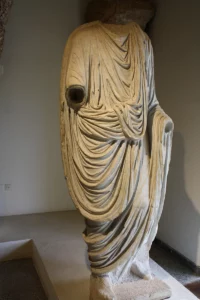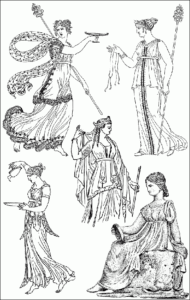People born in Ancient Rome were quite serious about their social appearance, particularly their dresses and distinctive clothing patterns. The Romans had a unique draping style that later influenced modern fashion and is still significantly dominant. Above everything, the Romans were quite constant with their clothing tradition. As per reports on clothing and fashion In Ancient Rome, certain dominant garments remained the same from the foundation days in 509 b.c.e. till the empire stood in ruins in 476 c.e. Only it was the materials used to make the garments, along with the décor, that underwent a transition from time to time.
As you move on in the blog, a comprehensive overview of the Roman clothing style awaits differentiation among men and women. The points together make it clear how life was back in Ancient Rome, especially regarding dressing sense.
Men’s Clothing And Fashion In Ancient Rome
As per reports, the people living in Wroxeter City back in Ancient Rome used tweezers to remove their armpit hair. Further studies suggest how Romans were obsessed with their cleanliness, and men from the elite class focused on removing body hair and maintaining a public image. As communal bathing was a part of their daily lives, these men owned their individual cleaning sets and had the slaves help them pluck off the body hair.

A Division Of Social Classes
Moving on to clothing and fashion In Ancient Rome, the Roman male was also particular about his dressing sense. And had a fixed style when it came to presenting themselves both inside and outside the house. However, in Rome, one’s dress symbolized their social standard. Hence, all the male members dressed according to their social class and not otherwise. The male citizens were divided into two social classes the plebeian and patrician.
- Patrician: The Patricians belonged to the old and prestigious families of Roman Senators.
- Plebeian: The Plebeians were the common men of Rome.
- Slaves: The bonded laborers of the society.
The Tunics And Toga
In Ancient Rome, Men wore tunics both inside and outside the home. Similar in appearance, the tunic’s material differed according to social class. The tunics worn by the slaves, herdsmen, and commoners were dark in color and usually made of coarse material. On the other hand, the Patricians wore white colored tunics made from linen or wool.
- Magistrates wore tunics known as augusticlavia,
- The one with broad strips called tunica laticlavia was worn by the Senators
- And the military people wore the shortest of the tunics

The males covered their tunics with a white wool coat called the Toga on special occasions. The particular came in different shapes – square or rectangle and was to be draped around the body. Through toga, one could understand a person’s social status.
- Councils and Senators had their togas edged with purple.
- Emperors had completely purple togas
- Also, a black toga was worn during mourning
Women And Their Clothes In Rome
Women were not usually termed a citizen in Ancient Rome. They were subjected to the class and rank of their father until they married. And then, after marriage, they took the husband’s social class. However, the women folk did have the right to property and were also covered by Roman law and order. But when it came to voting rights, they had none and mostly had to influence their husbands to vote their opinion.
However, women continued as the mother of the great rulers, commoners, and slaves in Ancient Rome and did have their own sense of fashion when it came to clothes. In the book “The Private Life of the Romans,” Harold Whetstone Johnston wrote how men and women wore similarly in ancient times, compared to the modern day. The main items were quite look-alike, while the name and fineness of the materials differed. Moving on with clothing and fashion In Ancient Rome, here is a brief overview of women and their fashion at that time.

The Tunica Or Tunics
While today, Tunica or Tunic are considered a primary piece of clothing that women can wear both under or over their dresses and only reaches to the knee. In Ancient Rome, the females could only wear tunics as an undergarment and tied a soft sash-like band made of leather closely under the breast as a steady support. No other than the young girls were allowed to wear tunics as a sole piece of clothing.
The Stola
Stola, also known as the tunica exterior, was worn over the latter. The clothing was open from both sides and fastened over the shoulders using brooches. In contrast to the tunica, stolas used to be of great length and came with sleeves only when the tunica didn’t have one. To cope with the great length of the stola, it was always worn with a girdle (zona) just above the hips. One used to adjust the stola through the girdle, pulling up the latter above the hip until it no longer touched the ground. This, in return, gave the women a fuller look on their upper body.
The Palla
The palla covered a women’s body outside the house. This was to be worn over the stola as a shawl-like wrap. One-third of the cloth was thrown over the left shoulder. It did touch the feet. The rest was carried forward, resting either over or under the arms of the wearer based on their convenience.
The Romans were not into hats, but they sometimes wore capes or hoods. And for the slaves, it was always a big no to cover their heads. Those who were free – wore a cone-shaped hat (Phrgygian) as the sign of their free will.
So that is all about clothing and fashion In Ancient Rome. The men had their dresses differentiated regarding social class, while the women made it official with multiple layers of clothing. Unlike the modern era, the Romans didn’t always wear pants. Instead, they had the garments freely flowing from the shoulders to the rest of the body, creating a fulfilling outlook.



